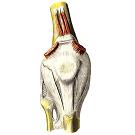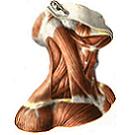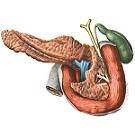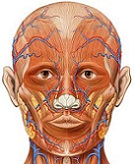Internal carotid artery
Internal carotid artery , a. Carotis interna, is a continuation of the common carotid artery. It distinguishes cervical, stony, cavernous and cerebral parts. Going upwards, it initially lies somewhat laterally and posteriorly from the external carotid artery.
Lateral from it is the internal jugular vein, v. Jugularis interna. On its way to the base of the skull, the internal carotid artery passes along the lateral side of the pharynx (the cervical part, pars cervicalis) medially from the parotid gland, separated from it by the hypoglossal and shillopharyngeal muscles.

In the cervical part, the internal carotid artery usually does not give out branches. Here it is somewhat expanded due to a sleepy sinus, sinus caroticus.
Going to the base of the skull, the artery enters the sleep canal, makes bends according to the bends of the canal (the stony part, pars petrosa) and upon exiting it enters through the lacerated hole into the cranial cavity. Here the artery goes in the carotid furrow of the sphenoid bone.
In the sleep channel of the pyramid of the temporal bone, the artery (rocky part) gives the following branches: 1) sleepy-drum arteries, aa. Caroticotympanicae, in the number of two or three minor stems, pass into the eponymous canal and enter the tympanum, blood supplying its mucous membrane; 2) artery of the pterygoid canal, a. Canalis pterygoidei, is guided through the pterygoid canal into the pterygoid palatine, blood supply to the pterygoid node.
Passing through the cavernous sinus (cavernous part, pars cavernosa), the internal carotid artery sends a series of branches: 1) to the cavernous sinus and the dura mater: a) the branch of the cavernous sinus, r. Sinus cavernosi; B) meningeal branch, r. Meningeus; C) basal branch of the outline, r. Basalis tentorii; D) edge branch of the project, r. Marginalis tentorii; 2) to the nerves: a) branch of the trigeminal node, r. Ganglioni trigemini; B) branches of nerves, rr. Nervorum, blood supply block, triple and draining nerves; 3) the lower pituitary artery, as well. Hypophysialis inferior, which, when approaching the lower surface of the posterior lobe of the pituitary gland, anastomoses with the terminal branches of other arteries, blood supplying the pituitary gland. Passing the cavernous sinus, the small wings of the sphenoid bone the artery approaches the lower surface of the brain (its cerebral part, pars cerebralis).
In the cranial cavity from the cerebral part of the internal carotid artery small branches branch to the pituitary: the upper pituitary artery, a. Hypophysialis superior, and branch of the ramp, r. Clivi, blood supply to the hard shell of the brain of this region.

From the brain part a. The carotis interna is leaving large arteries.
I. The eye artery, a. Ophthalmica, - a large pair of vessels. It is guided through the optic canal into the orbit, lying outside of the optic nerve. In the eye socket crosses the optic nerve, passing between him and the upper rectus muscle, is directed to the medial wall of the orbit. Having reached the medial angle of the eye, the eye artery disintegrates into terminal branches: the supraclavicular artery, a. Supratrochlearis, and the dorsal artery of the nose, as well. Dorsalis nasi. On its way the eye artery gives off branches (see "Organ of vision", vol. IV).
1. Lacrimal artery, a. Lacrimalis, begins from the eye artery in the place where it passes through the visual canal. In the orbit, the artery, located along the upper edge of the rectus lateral muscle and heading towards the lacrimal gland, gives twigs to the lower and upper eyelids - the lateral arteries of the eyelids, aa. Palpebrales laterales, and to the conjunctiva. The lateral arteries of the eyelids anastomose with the medial arteries of the eyelids, aa. Palpebrales mediales, with the help of an anastomotic branch, r. Anastomoticus, and form arcs of the upper and lower eyelids, arcus palpebrales superior et inferior.
In addition, the lacrimal artery has an anastomotic branch with the middle meningeal artery, r. Anastomoticus cum a. Meningea media.
2. Central artery of the retina, a. Centralis retinae, at a distance of 1 cm from the eyeball enters the thickness of the optic nerve and, reaching the eyeball, disintegrates in the retina into several radially divergent thin branches.
3. Short and long posterior ciliary arteries, aa. Ciliares posteriores breves et longae, follow along the optic nerve, penetrate the eyeball and are sent to the choroid.
4. Muscle arteries, aa. Musculares, upper and lower, break down into smaller branches that supply blood to the muscles of the eyeball. Sometimes they can move away from the tear duct.
From the muscle branches originate anterior ciliary arteries, aa. Ciliares anteriores, total 5-6. They go to the white shell of the eyeball and, penetrating through it, end in the thickness of the iris.

The branches of these arteries are:
A) anterior conjunctival arteries. Aa. Conjunctivales anteriores, blood supplying conjunctiva, covering the eyeball, and anastomosing with the posterior conjunctival arteries;
B) posterior conjunctival arteries, aa. Conjunctivales posteriores, which lie in the conjunctiva covering the eyelids, supply them with blood and anastomose with the arcs of the upper and lower eyelids;
C) episcleral arteries, aa. Episclerales. Blood supply to the sclera and anastomosing in its posterior parts with short posterior ciliary arteries.
5. Rear latticed artery, a. The ethmoidalis posterior, like the anterior one, departs from the eye artery in the area where it lies along the medial wall of the orbit in the region of the posterior third of the orbit and, having passed through the same hole, branches into the mucous membrane of the posterior trellised cells, giving off several small branches to the mucous membrane Posterior part of the septum of the nose.

6, Anterior lattice artery, a. Ethmoidalis anterior, penetrates through the same hole in the cavity of the skull and in the region of the anterior cranial fossa gives the anterior meningeal branch, r. Meningeus anterior. Then the artery goes down, passes through the opening of the trellis plate of the latticed bone into the nasal cavity, where it supplies the mucous membrane of the anterior part of the side walls, giving the lateral front nasal branches, rr. Nasales anteriores laterales, anterior septal branches, rr. Septales anteriores, as well as branches to the mucosa of anterior latticed cells.
7. Supraorbital artery, a. Supraorbitals, is located directly under the upper wall of the orbit, between it and the muscle lifting the upper eyelid. Going forward, bends the supraorbital margin in the area of the supraorbital notch, upward to the forehead area, where the blood supply to the circular muscle of the eye, the frontal abdomen of the cervical-frontal muscle and skin. The terminal branches of the supraorbital artery are anastomosed with a. Temporalis superficialis.
8. The medial arteries of the eyelids, aa. Palpebrales mediales, located along the free edge of the eyelids and anastomosing with the lateral arteries of the eyelids (r. A. Lacrimalis), forming the vascular arches of the upper and lower eyelids. In addition, they give two to three thin posterior conjunctival arteries, aa. Conjunctivales posteriores.
9. Suprablock artery, a. Supratrochlearis, - one of the terminal branches of the eye artery, is located inward from the supraorbital artery. It goes around the supraorbital margin, and, going upward, it supplies the skin of the medial parts of the forehead and muscle. Its branches are anastomosed with branches of the same-named artery of the opposite side.
10. Dorsal artery of the nose, a. Dorsalis nasi, as well as the supraclavicular artery, is the terminal branch of the eye artery. It is directed anteriorly, it lies over the medial ligament of the eyelid, gives the branch to the lacrimal sac and leaves on the back of the nose. Here it connects with the angular artery (branch a. Facialis), thus forming an anastomosis between the systems of the internal and external carotid arteries

II. Anterior cerebral artery, a. Cerebri anterior, rather large, begins at the point of separation of the internal carotid artery into terminal branches, passes forward and into the medial side, located above the optic nerve. Then wraps up, passes in the longitudinal slit of the large brain to the medial surface of the hemisphere. Then she goes around the knee of the corpus callosum, genu corporis callosi, and is guided along its upper surface back, reaching the beginning of the occipital lobe. At the beginning of its journey, the artery gives off a number of small branches that penetrate through the anterior perforated substance, substantia perforata rostralis (anterior), to the basal nuclei of the base of the large brain. At the level of the optic chiasma, chiasma opticum, the anterior cerebral artery is anastomosed with the same-named artery of the opposite side by the anterior connective artery, as well.
Communicans anterior.
In relation to the latter a. Cerebri anterior is divided into precomcommunication and post-communication parts.
A. The pre-communal part, pars precommunicalis, is the site of the artery from its origin to the anterior connective artery. From this part the central artery group leaves, aa. Centrales, in an amount of 10-12, penetrating through the forward perforated substance to the basal nuclei and the thalamus.
1. Anteromedial central arteries (anteromedial thalamostrial arteries), aa. Centrales anteromediales (aa. Thalamostriatae anteromediales), are directed upward, giving away the branches of the same name-the anteromedial central branches, rr. Centrales anteromediales, blood supplying the outer part of the nuclei of the pale sphere and the subthalamic nucleus.
2. Long central artery (recurrent artery), a. Centralis longa (a. Recurrens), rises somewhat upward, and then goes to the back, blood supplying the head of the caudate nucleus and partly the front leg of the inner capsule.
3. Short central artery, a. Centralis brevis, leaves alone or from a long central artery; Blood supply to the lower parts of the same area as the long central artery.
4. Anterior connective artery, a. Communicans anterior, is an anastomosis between the two anterior cerebral arteries. It is located in the initial section of these arteries, where they most closely converge before plunging into the longitudinal slit of the large brain.
B. Postcommunicational part (pericallos artery), pars postcommunicalis (a. Pericallosa), the anterior cerebral artery gives the following branches.

1. Medial fronto-basal artery, a. Frontobasalis medialis, departs from the anterior cerebral artery immediately after the divergence of the anterior connective branch, is directed anteriorly along the medial surface of the frontal lobe, and then passes to its lower surface, lying along a straight gyrus.
2. Horny-marginal artery, a. Callosomarginalis, is actually a continuation of the anterior cerebral artery. It is directed posteriorly, located along the edge of the corpus callosum, and at the level of its platen passes into the terminal branches of the medial surface of the parietal lobe.
From the callous-marginal artery, with the exception of the terminal branches, a series of vessels leaves along its course:
A) the anterior medial frontal branch, g. Frontalis anteromedialis, departs at the level of the lower part of the knee of the corpus callosum and, directed anteriorly and upward, is located on the medial surface of the frontal lobe along the upper frontal gyrus, supplying the anterior part of this region;
B) medial medial frontal branch, r. Frontalis intermediomedialis, departs from the callus-marginal artery approximately at the point of the knee transition into the corpuscle of the corpus callosum. It is directed along the medial surface to the top and divides in the region of the upper frontal gyrus into a number of branches that supply blood to the central parts of this region;
C) posterior medial frontal branch, r. Frontalis posteromedialis, more often starts from the previous branch, less often - from the callous-marginal artery and, going back and forth along the medial surface of the frontal lobe, blood supply this area, reaching the upper margin of the precentral gyrus;
D) the belt branch, r. Cingularis, moving away from the main trunk, goes to the back, lying in the course of the same gyrus; Ends in the lower parts of the medial surface of the parietal lobe;
E) paracentral artery, a. Paracentralis, a fairly powerful trunk, which terminates the callus-marginal artery. It is directed posteriorly and upward along the medial surface of the hemisphere at the boundary between the frontal and parietal lobes, branched in the region of the paracentral lobule. The branches of this artery are the pre-arterial artery, and, precunealis, which is directed posteriorly, passes along the medial surface of the parietal lobe along the anterior margin and blood supply this region, and parieto-occipital artery, as well. Parietooccipitalis, which lies along the anterior margin of the eponymous furrow, branched out in the region of the pre-wedge.

III. Middle cerebral artery, a. Cerebri media, the largest of the branches of the internal carotid artery, is its continuation. The artery enters the depth of the lateral sulcus of the large brain and should first be seen from the outside, and then upward and slightly posteriorly and emerges on the upper lateral surface of the cerebral hemisphere.
In the course of the process, the middle cerebral artery is divided topographically into three parts; Wedge-shaped - from the place of origin to immersion in the lateral furrow, islet, enveloping islet and passing in the depth of the lateral furrow, and the final (cortical) part emerging from the lateral groove on the verhnelateral surface of the hemisphere.
The sphenoid part, pars sphenoidalis, is the shortest. Its distal boundary after immersion in the lateral furrow can be considered the location of the divergence of the frontal-basal artery.
The anterolateral central arteries (anterolateral thalamostrial) arteries, aa, branch from the wedge-shaped part. Centrales anterolaterales (aa. Thalamostriatae anterolaterales), in an amount of 10-12, penetrating through the anterior perforated substance, then dividing into medial and lateral branches, which are directed upward. Lateral branches, rr. Laterales, blood supply the outer part of the lenticular nucleus - the shell, putamen, and the posterior parts of the outer capsule. Medial branches, rr. Mediales, approach the inner parts of the nuclei of the pale sphere, the knee of the inner capsule, the body of the caudate nucleus, and the medial nucleus of the galamus.
The island part, pars insularis, runs along the whole surface of the islet part in the depth of the lateral furrow, going somewhat upward and posteriorly, along the central furrow of the islet. From this part of the middle cerebral artery the following branches branch out.
1. Lateral front-basal artery (lateral orbital-frontal branch), a. Frontobasalis lateralis (r. Orbitofrontalis lateralis), directed anteriorly and outward, giving a series of branches lying on the lower surface of the frontal lobe, along the orbital furrows; Blood supply to the orbital gyrus. Sometimes one of the branches departs independently from the main trunk and lies most laterally-this is the lateral ophthalmic-frontal branch, r. Orbitofrontalis lateralis.
2. Ostrovye arteries, aa. Insulares, only 3 - 4, are directed upward, repeating the course of the island's meanders; Blood supply islet fraction.

3. Anterior temporal artery, a. Temporalis anterior, departs from the main trunk in the region of the anterior part of the lateral fovea of the large brain and, going first upwards, emerges through the lateral furrow at the level of the ascending branch of the furrow and goes down and forwards; Blood supply to the anterior sections of the upper, middle and lower temporal gyri.
4. The middle temporal artery, a. Temporalis media, departs from the middle cerebral artery somewhat distal to the previous, repeats its path; Blood supply to the middle sections of the temporal lobe.
5. Posterior temporal artery, a. Temporalis posterior, begins from the main trunk in the region of the posterior part of the lateral fovea of the large brain, posteriorly from the previous one, and, going out through the lateral furrow, is directed downward and posteriorly; Blood supply to the posterior sections of the upper and middle temporal gyri.
The final (cortical) part, pars lerminatis (corticalis), gives the largest branches, blood supplying the upper-lateral surface of the frontal and parietal lobes.
1. Artery of the precentral furrow, a. Sulci precentralis, leaving the lateral furrow, is directed upward along the furrow of the same name; Blood supply to the precentral gyrus and adjoining areas of the frontal lobe.
2. The artery of the central sulcus, a. Sulci centralis, departs from the main trunk somewhat distal to the previous one. Going upward and somewhat posteriorly, it repeats the course of the central furrow, branching into the adjacent portions of the cortex with the frontal and parietal lobes.
3. The artery of the postcentral groove, a. Sulci postcentralis, departs from the middle cerebral artery somewhat posteriorly from the previous one and, going out through the lateral furrow, goes up and back, repeating the course of the same furrow. The branches sprouting from it blood supply the postcentral gyrus.
Anterior parietal artery, a. Parietalis anterior, leaves the lateral furrow with a fairly powerful trunk and, rising upward and slightly posteriorly, gives a series of branches located along the upper parietal surface of the parietal lobe.
Its branches supply the anterior parts of the lower and upper parietal lobes.
5. Posterior parietal artery, a. Parietalis posterior, leaves the lateral furrow in the area of its posterior branch, heading posteriorly, the artery branching; Blood supply to the posterior sections of the upper and lower parietal lobules and the marginal gyrus.
6. The artery of the angular gyrus, a. Gyri angularis, emerges from the lateral furrow in its terminal section, and, going down and back, blood supply the angular convolution.
IV. Posterior connective artery, a. The communicans posterior (see Figure 747) originates from the internal carotid artery and, going posteriorly and slightly inward, approaches the posterior cerebral artery (branch of the basilar artery, a. Basilaris).

Thus, the posterior cerebral and posterior connective arteries, together with the anterior cerebral arteries and the anterior connective artery, participate in the formation of the cerebral arterial circle, circulus arteriosus cerebri. The latter, lying over the Turkish saddle, is one of the important arterial anastomoses. On the basis of the brain, the arterial circle of the large brain surrounds the visual crossover, the gray mound and mastoid bodies.
From the connecting arteries, which close the arterial circle, a series of branches leave.
Anteromedial central arteries, aa. Centrales anteromediales, move away from the anterior connective artery and, penetrating through the front perforated substance, supply blood to the nucleus of the pale sphere and the posterior stem of the inner capsule.
Posterior connective artery, a. Communicans posterior, gives away significantly more branches. They can be divided into two groups. The first are the branches that supply blood to the cranial nerves: the branch of the cross, r. Chiasmaticus, and the branch of the oculomotor nerve, r. Nervi oculomotorii. The second group includes the hypothalamic branch, r. Hypothalamicus, and the tail branch of the caudate nucleus. R. Caudae nuclei caudati.

V. Anterior villous artery, a. Choroidea anterior, starts from the posterior surface of the internal carotid artery and, laterally moving along the foot of the large brain, back and forth, approaches the anterior lobes of the temporal lobe. Here the artery enters the substance of the brain, giving off the villous branches of the lateral ventricle, rr. Choroidei ventriculi lateralis, which, branching into the wall of the lower horn of the lateral ventricle, enter their branches into the vascular plexus of the lateral ventricle, plexus choroideus ventriculi lateralis.
Immediately, short, villous branches of the third ventricle, rr. Choroidei ventriculi tertii, which are part of the vascular plexus of the third ventricle, plexus choroideus ventriculi tertii.
At the very beginning, the anterior villous artery gives off branches of the anterior perforated substance. Rr. Substantiae perforatae anteriores (up to 10), penetrating deep into the substance of the cerebral hemispheres.
A number of branches of the anterior villous artery approach the nuclei and the inner capsule of the hemisphere base: the tail branch of the caudate nucleus, rr. Caudae nuclei caudati, branches of the pale sphere, rr. Globi pallidi, branches of the amygdala, rr. Corporis amygdaloidei, the branches of the inner capsule, rr. Capsulae internae, or to the formations of the hypothalamus: branches of the gray hillock, rr. Tuberis cinerei, the branches of the nuclei of the hypothalamus, rr. Nucleorum hypothalamicorum. The nuclei of the legs of the brain supply the branches of black matter, rr. Substantiae nigrae, branches of the red nucleus, rr. Nuclei rubris. In addition, branches of the optic tract depart in this region, rr. Tractus optici, and branches of the lateral geniculate body, rr. Corporis geniculati lateralis.









Comments
When commenting on, remember that the content and tone of your message can hurt the feelings of real people, show respect and tolerance to your interlocutors even if you do not share their opinion, your behavior in the conditions of freedom of expression and anonymity provided by the Internet, changes Not only virtual, but also the real world. All comments are hidden from the index, spam is controlled.